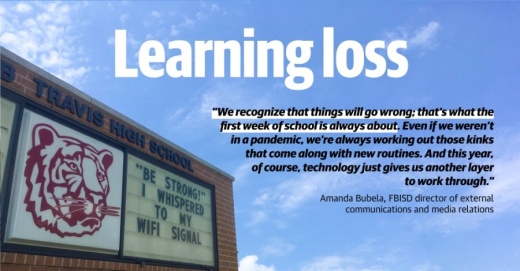As of press time Sept. 4, the district had applied for a waiver to allow online-only learning until Oct. 9. FBISD will phase in students who chose face-to-face learning by Oct. 12. All students will have the option to remain remote for the entire school year.
FBISD Superintendent Charles Dupre said district officials believe it will take two years to remedy the learning loss that happened when school closed for nine weeks at the end of the 2019-20 school year.
“We’re not seeing this as we come back to school, everything’s going to be back to normal quickly,” Dupre said. “We have revised our curriculum; we have revised our schedules, and we’re working with individual students to address their unique needs, but we know we’re in this for the long term.”
Acknowledging learning gaps
The distance learning environment is one in which Bob Sanborn, the president and CEO of Houston-based nonprofit Children At Risk, said is not on par with in-person learning.
“Online education is just not up to snuff; it’s just not where it needs to be for kids to be learning at the same levels,” Sanborn said. “That being said, you can’t send kids back to school if there’s a threat to their family and a threat to teachers.”
Bulent Dogan, a clinical assistant professor at the University of Houston’s Curriculum and Instruction Department, said some of the difficulties with distance education include a slower pace of instruction, less one-on-one direction and the inability to participate in hands-on learning activities.
“It’s no secret that the human brain can learn better through personal interaction and being physically present in the learning context; that’s a given,” said Dogan, who teaches at the UH at Sugar Land campus. “We learn by doing.”
Sanborn said the challenges with online learning will not affect all students and families in the same ways.
“Kids are not learning as much online as they would be in the classroom,” Sanborn said. “And that becomes especially true for kids that are low income, where a number of factors play out.”
Sanborn said for low-income families, parents typically are not able to be as engaged in their children’s education, may be less able to help teach at home, and may not have the same access to technology or knowledge of how to use that technology.
Dogan said the digital divide is one of the biggest hurdles to effective online education.
“Nowadays internet is as important as electricity, so you need to make sure everyone has internet so they can actually benefit from distance education,” he said.
FBISD has distributed 29,001 laptops, 5,317 iPads and 4,192 internet hot spots to students who requested them as of Aug. 28.
Still, inequity with online learning will play out with affluent students participating in learning pods and receiving private tutoring that will put them ahead in terms of competing for spots at colleges, taking rigorous Advanced Placement tests and entering the workforce, Sanborn said.
“Those kids will be OK, but the vast majority of kids are not just going to be a little behind them—they’re gonna be really behind them,” Sanborn said.
However, Sanborn said the threat of learning loss is particularly strong for the youngest students—those in pre-K through second grade—who are working on foundational skills.
The disruption to student learning could be profound, with one national study of 5 million students by the Northwest Evaluation Association projecting the combination of a typical “summer slide” and learning during COVID-19 could cause as much as a full grade level of regression for some students.
Susan King, youth services coordinator at Fort Bend County Libraries, encouraged students and families to use all of the digital resources—such as Brainfuse, which connects students to homework tutors—the library offers. She called these resources the “best-kept secrets” of the library.
“We see ourselves as a support to the school district and to the students as they go back to school,” King said.
District flexibility
Throughout the summer and into the beginning of the school year, FBISD officials stressed remote education this fall will look different from online learning implemented in the spring.
Melissa Hubbard, executive director of FBISD’s teaching and learning department, outlined four main ways online learning has improved since the spring.
One key change, Hubbard said, is a structured school schedule, which designates specific times for synchronous and asynchronous learning. Synchronous learning occurs when both the teacher and students are engaged online together, while asynchronous learning is time designated for students to practice concepts and demonstrate their understanding.
Furthermore, Hubbard said the district is teaching all of the required state standards, resuming testing used for diagnostic and progress monitoring, and reinstating the district’s precoronavirus grading system.
District administrators said the bulk of the challenges with online learning so far have stemmed from technology issues such as internet connectivity as well as hardware and software issues.
“We recognize that things will go wrong; that’s what the first week of school is always about,” said Amanda Bubela, FBISD’s director of external communications and media relations. “Even if we weren’t in a pandemic, we’re always working out those kinks that come along with new routines.”
FBISD presented a plan to phase students back into the classroom for face-to-face learning at the Sept. 2 board meeting. Once schools reopen, the district’s Pandemic Management Plan will guide the district’s decision on when to close campuses because of coronavirus cases or outbreaks.
The Pandemic Management Plan uses a series of indicators to determine the risk level for each campus and district building. The risk level governs whether learning at that school will be online or in person and the degree to which students participate in extracurricular activities.
“The goal of the Pandemic Management Plan is to ensure uninterrupted learning,” FBISD Assistant Superintendent Carmela Levy-David said at the Aug. 17 meeting.
Struggles for parents
Still, for many working parents, online learning has put them in a difficult position, with many parents having to decide whether they would leave their children at home or modify their work schedule.
To address this need in the community, FBISD has opened a select number of learning centers for homeless students and children of FBISD staff and essential workers. However, more than 6,000 elementary students applied for 1,672 available seats, leaving a long waitlist.
The district has also partnered with private child care centers, tutoring businesses and Montessori schools to train them on how to use FBISD’s online tools.
Furthermore, nonprofit organizations in the community—including the YMCA of Greater Houston and Boys and Girls Clubs of Greater Houston—are providing safe spaces for children to engage in their district curriculum.
Dupre said he empathizes with parents who are trying to monitor their child’s education while working but that in some ways, “it is what it is.”
“While we’re online that’s going to be the reality, and I hate that for parents who are caught in that trap,” Dupre said.
Matt Dulin contributed to this report.





